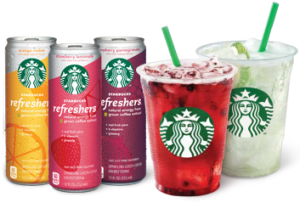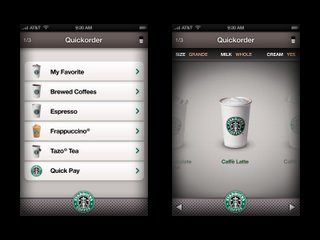 Sometimes it is better to be late than never. Starbucks recently announced a new line of energy drinks – Starbucks Refreshers. There are two flavors Cool Lime and Very Berry Hibiscus and instead of copying other energy drinks, and use the same active ingredients as the usual suspects, they instead decided to use something uniquely Starbucks – green coffee extract.
Sometimes it is better to be late than never. Starbucks recently announced a new line of energy drinks – Starbucks Refreshers. There are two flavors Cool Lime and Very Berry Hibiscus and instead of copying other energy drinks, and use the same active ingredients as the usual suspects, they instead decided to use something uniquely Starbucks – green coffee extract.
Starbucks Refreshers are coffee drinks that don’t look like or taste like coffee, but provide the caffeine jolt that many of their customers are looking for nonetheless. And as an added bonus, they are coffee drinks that are much lower in calories and fat than many of their traditional hot or iced lattes. Coffee for the lactose intolerant too!
Starbucks has done something else smart, and that is that they have created a self-reinforcing product loop that allows for three different preparations and use cases for the same basic product, all in a single summer product launch:
- A customizable cafe preparation with multiple sizes and fresh fruit
- A canned, chillable pre-mixed portable preparation
- An extremely portable VIA DIY preparation without the water
In addition to being sold in their stores and licensed locations, the can and VIA preparation can be distributed via Starbucks’ existing grocery distribution channels.
Starbucks Refreshers are a great example of taking components of your brand and other organizational assets and leveraging them to create new products that people might not have thought about you creating, but that feel like natural extensions to them instead of a stretch.
Starbucks Refreshers are also a great example of looking at your raw materials in a new way and as a result a new product solution in born.
What might happen if you looked at your raw material inputs in a new way?
![]() Sign up here to get Human-Centered Change & Innovation Weekly delivered to your inbox every week.
Sign up here to get Human-Centered Change & Innovation Weekly delivered to your inbox every week.

 If you missed How Leading Organizations Manage Their Open Innovation and Crowdsourcing Efforts – Part One, you can
If you missed How Leading Organizations Manage Their Open Innovation and Crowdsourcing Efforts – Part One, you can  I came across a queue reduction application for the iPhone and iPod Touch four years ago that was intriguing. At the time it looked like the application wasn’t quite finished or certified for use yet by Apple and Starbucks, but from what I gathered at the time it was meant to work something like this:
I came across a queue reduction application for the iPhone and iPod Touch four years ago that was intriguing. At the time it looked like the application wasn’t quite finished or certified for use yet by Apple and Starbucks, but from what I gathered at the time it was meant to work something like this: I’ve been meaning to write this post for some time, and am finally getting around to it, so hear goes…
I’ve been meaning to write this post for some time, and am finally getting around to it, so hear goes… For those of you not familiar with the
For those of you not familiar with the